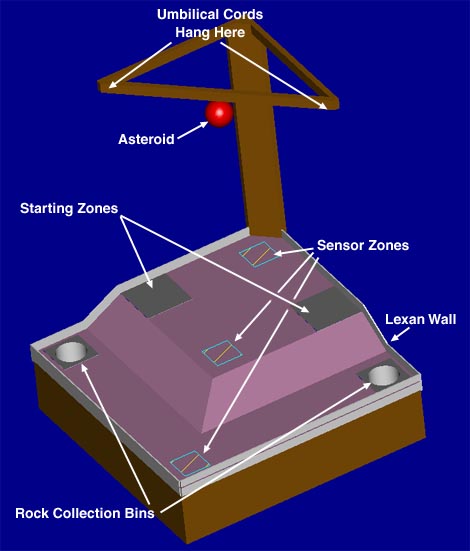

May 8th and 9th 2000, MIT's Johnson Athletic Center
Warning these rules have not been finalized yet!!! They will be finalized by 1 FEB 2000.
Goals:The contest has the following goals:
History shows the contest is 50% designing and building, and 50% driving. So finish building early and leave plenty of time for practice driving and debugging (1 to 2 weeks is good). Rules:The contest is a single elimination ladder. with a pair of machines competing head to head against each other in each round. Each round of the contest is 45 seconds long.
|
| See the Table Dimension
Section for the specific dimensions. You can also download the Pro/Engineer part
file of the table (coming soon). This configuration may evolve slightly over the course of the semester. Emails will be sent and announcements made in lecture, but please check back here occasionally to double check. Surface:The surface of the table is indoor/outdoor carpet. Rocks:The rocks on the table range in size from pebbles through gravel up to softball size rocks. XX Gallons of rocks will be evenly distributed over the upper table playing surface. XX Gallons of rocks will be evenly distributed on the lower playing surface. No rocks will be placed on the sloped walls. The carpet does bulge a bit at the intersection of the two slopes. See the photo for the approximate size. Starting Zone:The starting zones consist of an 18" x 18" piece of sheet steel screwed to the table. It is mounted at the top of the hill. The starting zone extends 1.5 inches beyond the outside surface of the wall. Machines may only be touching the steel starting surface at the beginning of the contest. Walls:The walls around the table edge are made of 1/2" Lexan. They are 3.5 inches above the surface of the table. Umbilical Cords:The umbilical cords are hung from either corner of the tree. The PucksEach puck is XX inches in diameter and XX inches thick. They weigh XX each. The AsteroidThe asteroids are rubber kick balls 7 inches in diameter. There are mostly filled with water. They wiegh approximately 6 lbs. Since they are not completely full of water they are not round and slosh around a bit as they roll. They are released by an electromaget halfway though the contest. |

The 2.007 table as of 29 NOV 99. The side walls have not been built, nor the holes addeds, not starting zones. |